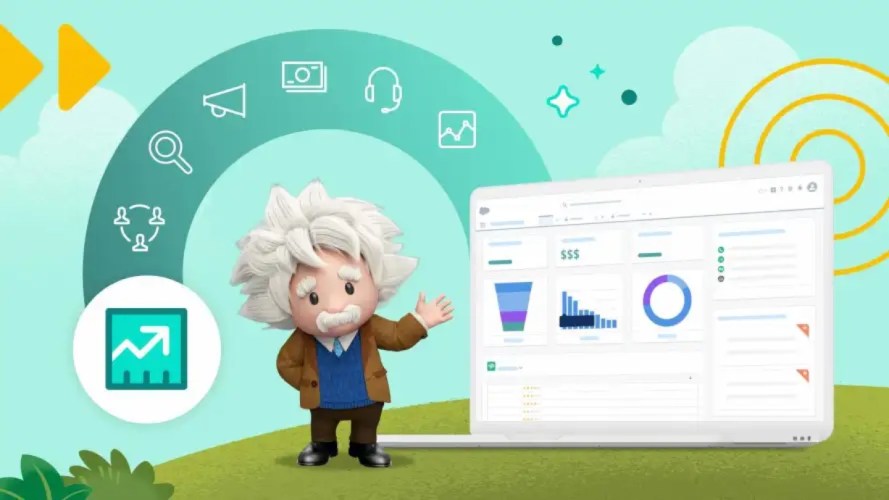What are conversion rates?



Explore how to optimise your site's conversion rate in this blog. Learn effective strategies to convert more visitors using Salesforce and increase your growth.
Salesforce Staff
Conversion rate is a crucial metric that measures the effectiveness of your website or app in converting visitors into customers. It’s the percentage of visitors who take a desired action, such as making a purchase, signing up for a newsletter, or downloading an app. Understanding conversion rate is essential for businesses looking to optimise their online presence and drive growth. In this blog post, we’ll explore what conversion rate is, how to calculate it, why it’s important, and how to improve it. We’ll also provide conversion rate benchmarks and tips for enhancing your website’s conversion rate with Salesforce, the world’s leading customer relationship management (CRM) platform.
The definition of conversion rate
Conversion rates are a key metric that measures the effectiveness of your website or app in converting visitors into customers. It is calculated as the percentage of visitors who take a desired action, such as making a purchase, signing up for a newsletter, or downloading an app. In simpler terms, it represents the ratio of the number of conversions to the total number of visitors or sessions on your website or app.
Conversion rate serves as a valuable indicator of how well your website or app is achieving its intended goals. By monitoring and analysing conversion rates, businesses can gain insights into the effectiveness of their marketing campaigns, website design, user experience, and overall performance. It helps identify areas for improvement and allows businesses to make data-driven decisions to optimise their online presence and drive growth.
Furthermore, conversion rate optimisation plays an essential role in tracking the success of specific initiatives, such as marketing campaigns, website redesigns, or the introduction of new features. By comparing conversion rates before and after implementing changes, businesses can quantify the impact of their efforts and make informed decisions about future strategies.
Effective conversion rate optimisation strategies
1. Homepage Optimisation Opportunities The homepage serves as the initial point of contact for website visitors, making it crucial for a positive first impression and pivotal in retaining visitor interest to delve deeper into your site.
Enhancements can include highlighting links to the product pages for details, promoting a free registration option, or integrating a chatbot to engage with visitors and answer their questions throughout their site exploration.
2. Enhancements for Pricing Pages The pricing page often determines whether visitors proceed to purchase.
Utilising CRO techniques here can transform browsers into buyers by tweaking pricing structures (e.g., annual vs. monthly fees), elaborating on product features for different pricing tiers, providing contact options for direct inquiries, or introducing interactive elements like pop-up forms. An example of successful implementation is Hotjar, which added an email opt-in popup on its pricing page, resulting in over 400 new leads within three weeks.
3. Blog Conversion Strategies Blogs represent a significant opportunity for conversions by not only offering valuable industry insights but also by integrating effective CRO strategies to drive conversions and turn readers into leads.
Tactics might include embedding multiple calls-to-action throughout posts, or promoting content offers like ebooks or reports in exchange for reader email addresses.
4. Landing Page Enhancements Given their direct call to action, landing pages typically exhibit the highest conversion rates among all types of signup forms—an impressive average of 23%.
For example, an event landing page might feature a video from a previous event to boost registration rates for the current year, while a resource offering page could showcase snippets of content to entice downloads.
Understanding When to Initiate CRO Knowing the best areas to apply CRO is key to conversion optimisation, and it’s equally important to recognise the right time to begin optimising your site for improved conversion rates.
How to calculate conversion rates
To calculate your conversion rate, you need to know the number of visitors who took the desired action and the total number of visitors to your website or app during a specific time period. The formula for conversion rate is:
Conversion Rate = (Number of conversions / Total number of visitors) * 100For example, if 100 people visit your website and 10 of them make a purchase, your conversion rate would be 10%.
You can track your conversion rates over time using Google Analytics or other analytics tools. This will help you see how your conversion rates are trending and identify any areas where you need to improve.
Conversion rates can vary depending on a number of factors, including:
- The type of website or app you have
- The target audience you are targeting
- The traffic source (e.g., organic search, paid advertising, social media)
- The landing page that visitors are directed to
It is important to track and analyse your site’s conversion rate and rates so that you can make data-driven decisions to improve your website or app and drive growth.
Conversion rates are a key metric for measuring the success of your business. They measure the success of your marketing and sales efforts, help you identify areas for improvement in your sales funnel, allow you to compare your performance and conversion funnel to industry benchmarks, and can help you to optimise your website and marketing campaigns.
By tracking conversion rates, you can gain insights into the effectiveness of various channels and strategies. This enables you to allocate your resources more efficiently, focusing on the methods that yield the highest returns. Moreover, conversion rates help you identify potential bottlenecks in your sales funnel, allowing you to rectify issues and enhance the overall customer experience.
Furthermore, conversion rates serve as a benchmark for measuring your performance against competitors. By comparing your conversion rates to industry standards, you can assess your competitiveness and make necessary adjustments to improve your position in the market. Additionally, conversion rates provide valuable data for A/B testing and website optimisation. By experimenting with different elements of your website or app, you can determine what works best for your audience and optimise the user experience accordingly.
In essence, conversion rates are crucial for businesses aiming to grow their customer base and revenue. By closely monitoring and analysing conversion rates, businesses can make informed decisions, optimise their marketing strategies, and enhance their overall performance.
Conversion rate optimisation
(CRO) is the process of increasing the percentage of visitors to your website or app who take a desired action, such as making a purchase or signing up for a service. It involves a data-driven approach to analysing and optimising your website or app to improve its effectiveness in converting visitors into customers.
There are five key areas to focus on when optimising your conversion rate:
1. Testing different versions of your website or landing page. A/B testing allows you to compare different versions of your website or landing page to see which one performs better. You can test different elements, such as the headline, call to action, or the web page layout, to determine what resonates most with your target audience.
2. Personalising your website or landing page to your target audience. Personalisation involves tailoring your website or landing page to the specific interests and needs of your target audience. This can be done by using data from your analytics platform to identify the demographics, interests, and behaviours of your visitors.
3. Using clear and concise calls to action. Your call to action (CTA) is what tells visitors what you want them to do next. Make sure your CTA is clear, concise, and easy to find. It should also be relevant to the content on the page and the needs of your target audience.
4. Making it easy for visitors to convert. The checkout process should be as simple and straightforward as possible. Avoid asking potential customers for unnecessary information, and make sure the payment process is secure and easy to understand.
5. Tracking your results and optimising your campaigns accordingly. It’s important to track your conversion rates so that you can see what’s working and what’s not. This will allow you to make data-driven decisions about how to optimise your website or app for better conversions.
By following these five steps, you can improve your conversion rate, increase conversions, and drive more growth for your business.
Conversion rate benchmarks
This section provides conversion rate benchmarks for different industries, services and businesses. It discusses the average conversion rate for all industries, as well as the full conversion rate optimisation process and rates for high-performing websites, B2B websites, and mobile websites.
The average conversion rate for all industries is around 2-3%. This means that for every 100 visitors to a website, 2-3 will take the desired action. However, there is a significant variation in conversion rates between different industries. For example, the average conversion rate for e-commerce websites is around 4%, while the average conversion rate for lead generation websites is around 2%.
High-performing websites typically have a conversion rate of 5% or higher. These websites are typically well-designed, easy to use, and have a clear call to action. They also tend to have a strong value proposition and a targeted marketing strategy.
B2B websites typically have a lower conversion rate than e-commerce websites. This is because B2B sales cycles are typically longer and more complex. B2B websites typically have a conversion rate of around 2-3%.
Mobile devices and websites typically have a lower conversion rate than desktop websites. This is because it can be more difficult to design a mobile website that is easy to use and navigate. Mobile websites typically have a conversion rate of around 1-2%.
It is important to note that conversion rates can vary significantly depending on a number of factors, such as the type of website or app, the target audience, the traffic source, and the landing page that visitors are directed to. Businesses should track and analyse their conversion rates over time to identify areas for improvement.
Improving your conversion rate with Salesforce
Salesforce is a powerful customer relationship management (CRM) tool that can help you improve your conversion rate in a number of ways. Here are a few tips:
Track and test your landing web pages, forms, and CTAs: Salesforce allows you to track the performance of your landing pages, forms, and calls to action (CTAs). This information can help you identify which elements are working well and which ones need to be improved. You can then use this information to make changes to your website or app and improve your conversion rate.
Create targeted and personalised marketing campaigns: Salesforce allows you to create targeted and personalised marketing campaigns based on your customer data. This information can help you send the right messages to the right people at the right time, which can increase your chances of converting them into customers.
Track and analyse your customer journey: Salesforce allows you to track the customer journey from the moment they first visit your website or app to the moment they make a purchase. This information can help you identify any bottlenecks or drop-off points in your sales funnel and make changes to improve your conversion rate.
Automate your marketing and sales processes: Salesforce can help you automate your marketing and sales processes, which can free up your time to focus on other tasks. This can help you improve your efficiency and productivity, which can lead to more conversions and increased sales and revenue.
By following these tips, you can use Salesforce to improve your conversion rate and grow your business.




















